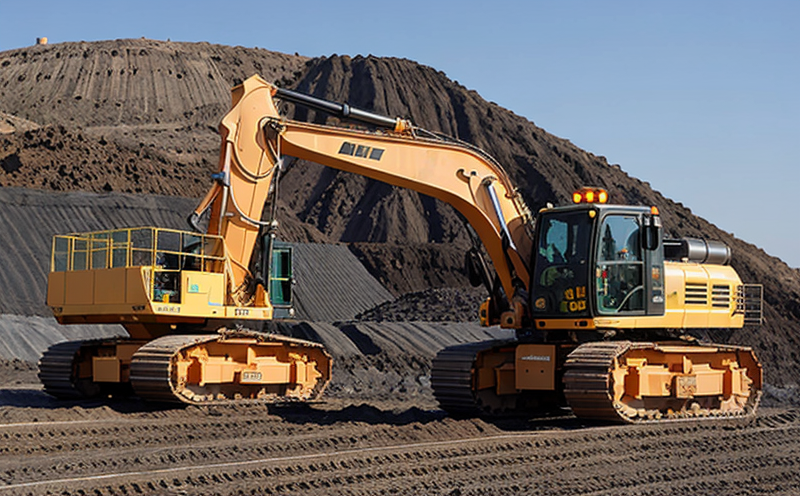EN 474 Earth Moving Machinery Safety and Performance Testing
The European Standard EN 474 sets forth comprehensive requirements for ensuring safety and performance of earth-moving machinery. This service focuses on the rigorous testing procedures required to meet these standards, which are essential for compliance with international regulations in mining operations.
Earth-moving machinery is a critical component in various sectors including construction, infrastructure development, and mining. Compliance with EN 474 ensures that the equipment not only meets safety standards but also performs optimally under real-world conditions. This standard covers a range of aspects such as structural integrity, noise levels, emissions, and operational efficiency.
The testing process involves several stages to ensure thorough evaluation. Initially, the machinery is subjected to static load tests to assess its structural stability. Following this, dynamic performance tests are conducted to measure factors like fuel consumption, speed, and overall efficiency. Noise and vibration levels are also monitored closely as part of these assessments.
For compliance with EN 474, it's crucial that the machinery is tested under controlled conditions that mimic its actual operational environment. This includes simulating various terrains and working conditions to evaluate how well the equipment functions in real-world scenarios. The testing process typically involves collaboration between the manufacturer, the laboratory, and end-users to ensure all aspects of safety and performance are covered.
One of the key challenges in this testing is ensuring that the machinery meets both static and dynamic requirements simultaneously. This dual approach ensures that not only does the equipment perform well under stress but also operates safely over extended periods. Compliance with EN 474 can significantly enhance the reputation of a mining company by demonstrating its commitment to safety and environmental responsibility.
The standard's emphasis on reducing noise pollution is particularly beneficial in mining operations where prolonged exposure to high decibel levels can be harmful to workers' health. By adhering to these standards, companies can contribute to a safer working environment while also minimizing their environmental footprint. This commitment to sustainability aligns with global trends towards greener practices and could provide a competitive edge in the market.
Why Choose This Test
- Comprehensive Compliance: Ensures full compliance with EN 474, providing peace of mind for regulatory adherence.
- Rigorous Testing Protocols: Utilizes state-of-the-art facilities and equipment to conduct thorough evaluations.
- Expert Guidance: Leverage the expertise of our team who have extensive experience in mining equipment testing.
Environmental and Sustainability Contributions
The testing process for EN 474 not only ensures safety but also plays a crucial role in promoting environmental sustainability. By reducing noise pollution, minimizing fuel consumption, and enhancing operational efficiency, the equipment tested under this standard contributes significantly to a greener mining operation.
Reducing noise levels is particularly important as it helps protect workers from long-term health issues such as hearing loss. Additionally, lower emissions contribute to cleaner air in mining environments, which can have broader positive impacts on local ecosystems. Enhanced operational efficiency leads to reduced fuel consumption and longer equipment lifespan, all of which are beneficial for both the environment and profitability.
Furthermore, adhering to EN 474 standards helps companies align with international sustainability initiatives. This alignment can enhance a company's reputation among environmentally conscious stakeholders, including customers, investors, and regulators. By demonstrating a commitment to reducing the environmental impact of mining operations, companies can also open up new markets where sustainability is a key consideration.
The testing process for EN 474 is designed not only to meet current regulations but also to anticipate future requirements. As environmental concerns continue to grow globally, compliance with such standards will become increasingly important. By staying ahead of these trends, companies can ensure they are prepared for any regulatory changes and maintain their competitive edge.
Competitive Advantage and Market Impact
- Enhanced Reputation: Demonstrating compliance with EN 474 can significantly enhance a company’s reputation, making it more attractive to customers and investors.
- Innovation Leadership: By staying ahead of regulatory trends, companies can position themselves as leaders in innovation within the industry.
- Better Decision-Making: Testing under these standards provides valuable data that can inform better decision-making processes for equipment procurement and maintenance strategies.
Compliance with EN 474 is not just about meeting regulatory requirements; it's also about building a strong foundation for long-term success. By ensuring safety, performance, and environmental responsibility, companies can differentiate themselves in the market and build trust among stakeholders.
The global mining industry is increasingly focusing on sustainability as part of its strategy to address growing concerns over resource depletion and environmental degradation. Companies that are proactive in adopting such standards will be better positioned to meet these challenges head-on. This foresight can lead to significant competitive advantages, including increased market share and improved operational efficiency.





